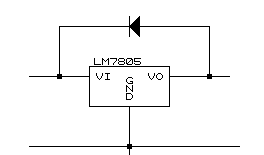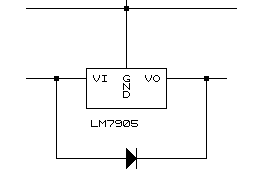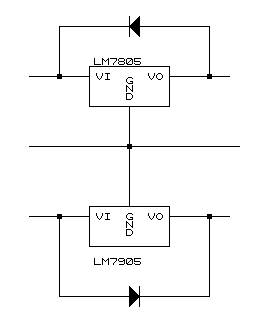|
1
|
the descriptions that follow are for basic regulator circuits, using the 78xx and 79xx series.
|
| 2
|
principle of operation :
- the regulator simply calls for a filtered voltage input connected to its input terminal.
- the common is connected to ground, and the regulated positive voltage output is connected to the circuit.
- a regulator chip of this series must be provided with a heat sink which will dissipate the power according to the calculation below.
- power = (voltage, say 15 volts) * (current, say 1000 ma at the output of the 5-volt regulator + 100 ma for internal consumption).
- power = (12-5) * ((1000 + 100)/1000) = 7.7 watts, say 10 watts.
- note that power is larger if the difference between the input and output voltages is large.
- as a rule of thumb from practice, however, a voltage regulator circuit should have an input/output difference of about 7 volts to account for transients, temperature, and other unforeseen conditions.
- the "reverse-biased" diode is a very important device for the protection of the system. it provides a shunt path for the current if the output happened to experience a high voltage transient, while the input is connected to a capacitor with a large value.
go to top next
|

|
|
| 3
|
principle of operation :
- this second circuit is a negative voltage regulator.
- what is said about the circuit above can also be said about this one.
- for all practical purposes, they are identical.
go to top prev
|

|
|
| 4
|
it is worthwhile keeping in mind that the minimum value of the filtered positive ripple voltage should clear the ground (common) by about 7 volts, and the maximum ripple voltage at the negative supply should also be about 7 volts below gound (common) voltage.
|

